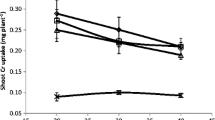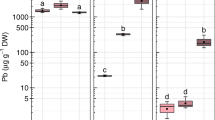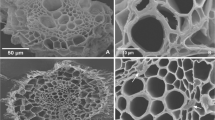Abstract
Comparisons of relative growth and survival rates of 10 plant species in test-tube nutrient-solution culture indicated that soybean and sunflower were Cr-tolerant. Comparison of relative growth and tissue Cr concentrations between soybean and sunflower showed that soybean was most tolerant to both Cr(VI) and Cr(III). Higher tissue Cr concentrations (20 000, 7400, 1300 μg g−1 in the roots, stems, and leaves, respectively) were observed in all soybean tissues when exposed to 1.0 mM Cr(III) as compared to sunflower (14 000, 900, 460 μg g−1 in the roots, stems, and leaves, respectively). With Cr(VI), sunflower had higher Cr concentrations in the root than did soybean (1800 vs. 700 μg g−1); however, there was a higher Cr level in soybean leaves and stems (27 and 21 μg g−1, respectively) compared to leaves and stems of sunflower (6 and 0 μg g−1, respectively), indicating significant translocation from the roots into the above-ground parts in soybean. Soybean can be considered to be a viable candidate as a rhizofiltration species for phytoremediation purposes.
Similar content being viewed by others
References
Banuelos G S, Ajwa H A, Mackey M, Wu L, Cook C, Akohoues and Zambruzuski S 1997 Evaluation of different plant species used for phytoremediation of high soil selenium J. Environ. Qual. 26 (3): 639–646.
Barthakur B and Gogoi P 1995 Growth stimulation of soybean (Glycine max) by vesicular arbuscular mycorrhiza in different phosphate levels Adv. Plant Sci. 8 (1) (Suppl.), 96–99.
Bartlett R J 1991 Chromium cycling in soils and water: links, gaps, and methods Environ. Health Perspect. 92, 17–24.
Bowers L J and Melhuish J H 1988 Comparison of elemental concentrations in the wood of three tree species growing adjacent to an inactive chromium smelter Bull. Environ. Contam. Toxicol. 40(3), 457–461.
Bridgewater L C, Manning F C R and Patierno S R 1994 Basespecific arrest of in vitro DNA replication by carcinogenic chromium: relationship to DNA interstrand crosslinking Carcinogenesis (Oxford) 15 (11), 2421–2427.
Brooks R R 1998 Plants That Hyperaccumulate Heavy Metals. CAB International, New York.
Cary E E and Olson O E 1975 Atomic absorption spectrophotometric determination of chromium in plants J. Assoc. Off. Anal. Chem. 58, 433–435.
Cary E E, Allaway W H and Olson O E 1977a Control of chromium concentrations in food plants. 1. Absorption and translocation of chromium by plants J. Agric. Food Chem. 25 (2), 300–304.
Cary E E, Allaway W H and Olson O E 1977b Control of chromium concentrations in food plants. 2. Chemistry of chromium in soils and its availability to plants J. Agric. Food Chem. 25 (2), 305–309.
Hinson K and Hartwig E E 1982 Soybean Production in the Tropics. 5 pp. Food and Agriculture Organization of the United Nations Rome, Italy.
Huffman E W D and Allaway W H 1973 Chromium in plants: distribution in tissues, organelles, and extracts and availability of bean leaf Cr to animals J. Agric. Food Chem. 21 (6), 982–984.
Kanazawa K, Higuchi K, Nishizawa N L, Fushiya S, Chino M, and Moris S 1994. Nicotianamine aminotransferase activities are correlated to the phytosiderophore secretions under Fe-deficient conditions in Gramineae J. Exp. Bot. 45 (281), 1903–1906.
Kleiman I D and Cogliatti D H 1998 Chromium removal from aqueous solutions by different plant species. Environ. Technol. 19, 1127–1132.
Liu K J, Jiang J, Shi X L, Gabrys H, Walczak T and Swartz H M 1995 Low-frequency EPR of chromium (V) from chromium (VI) in living plants Biochem. Biophys. Res. Commun. 206 (3), 829–834.
Lyon G L, Peterson P J, Brooks R R and Butler G W 1971 Calcium, magnesium and trace elements in a New Zealand serpentine flora J. Ecol. 59, 421–429.
Lytle C M, Lytle F W, Yang N, Qian J H, Hansen D, Zayed A and Terry N 1998 Reduction of Cr(VI) to Cr(III) by wetland plants: Potential for in situ heavy metal detoxification Environ. Sci. Technol. 32 (20), 3087–3093.
Mertz W 1969 Chromium occurrence and function in biological systems Physiol. Rev. 49 (2), 163–239.
Murashige T and Skoog F A 1962 A revised medium for rapid growth and bioassay with tobacco tissue cultures Physiol. Plant 15, 473–497.
Nriagu J O 1990 Trace metal pollution of lakes: a global perspective. In 2nd International Conference, Trace metals in aquatic environment, November 1990, Sydney, Australia.
Palmer C D and Wittbrodt P R 1991 Processes affecting the remediation of chromium-contaminated sites. Environ. Health Perspect. 92, 25–40.
Pawlisz A V, Kent R A, Schneider U A and Jefferson C 1997 Canadian water quality guidelines for chromium Environ. Toxicol. Water Qual. 12 (2), 123–183.
Probst A E and Judd R W 1973 Origin, U.S. history and development and world distribution. In Soybeans: Improvement, Production, and Uses eds B E Caldwell et al. pp 1–15. Am. Soc. Agron. Madison WI.
Qiu J H, Zayed A, Zhu Y L, Yu M and Terry N 1999 Phytoaccumulation of trace elements by wetland plants: III. Uptake and accumulation of ten trace elements by twelve plant species J. Environ. Qual. 28, 1448–1455.
Salt D E, Blaylock M, Nanda P B A K, Dushenkov V, Ensley B D, Chet I and Raskin I 1995 Phytoremediation: a novel strategy for the removal of toxic metals from the environment using plants Bio/Technology 13, 468–473.
Salt D E, Smith R D and Raskin I 1998 Phytoremediation Annu. Rev. Plant Physiol. Plant Mol. Biol. 49, 643–668.
Schroeder H A 1968 The role of chromium in mammalian nutrition Am. J. Clin. Nutr. 21, 230.
Shahandeh H and Hossner LR 2000a Plant screening for chromium phytoremediation. Int. J. Phytor. 2(1), 31–51.
Shahandeh H and Hossner LR 2000b Enhancement of Cr(III) phytoremediation. Int. J. Phytor. 2(3), 269–286.
Shewry P R and Peterson P J 1974 The uptake and translocation of chromium by barley seedlings (Hordeum vulgare L.) J. Exp. Bot. 25, 785–797.
Sklar F H 1980 A preliminary comparison of the uptake of chromium-51 and zinc-65 by three species of aquatic plants from Louisiana: Spirodela punctata, Eacopa caroliniana, Elodea canadensis Proc. La Acad. Sci. 43, 46–51.
Soane B D and Saunder D H 1959 Nickel and chromium toxicity of serpentine soils in southern Rhodesia Soil Sci 94, 322–329.
Staves R P and Knaus R M 1985 Chromium removal from waters by three species of duckweeds. Aquat. Bot. 23, 261–273.
Tang T J and Miller D M 1991 Growth and tissue composition of rice grown in soil treated with inorganic copper, nickel, and arsenic Commun. Soil Plant. Anal. 22 (19-20), 2037–2045.
Turner M A and Rust R H 1971 Effects of chromium on growth and mineral nutrition of soybeans Soil Sci. Soc. Am. Proc. 35 (5), 755–758.
Underwood E J 1971 Trace Elements in Human and Animal Nutrition, 3rd edn. pp 253–264. Academic Press, New York.
Walter M 1969 Chromium occurrence and function in biological systems Physiol. Rev. 49, 163–239.
Wei LC, Ocumpaugh W R, and Loeppert RH 1994 Differential effect of soil temperature on iron-deficiency chlorosis in susceptible and resistant subclovers Crop Sci. 34 (3), 715–721.
Wild H 1974 Indigenous plants and chromium in Rhodesia Kiekia 9, 233–241.
Witmer C M, Harris R and Shupack S I 1991 Oral bioavailability of chromium from a specific site Environ Health Perspect. 92, 105–110.
Zayed A, Lytle C M, Qian J H and Terry N 1998 Chromium accumulation, translocation and chemical speciation in vegetable crops Planta 206(2), 293–299.
Zhitkovich A, Voitkun V, Kluz T and Costa M 1998 Utilization of DNA-protein cross-links as a biomarker of chromium exposure Environ Health Perspect. 106 (Suppl 4), 969–974.
Author information
Authors and Affiliations
Corresponding author
Rights and permissions
About this article
Cite this article
Mei, B., Puryear, J.D. & Newton, R.J. Assessment of Cr tolerance and accumulation in selected plant species. Plant and Soil 247, 223–231 (2002). https://doi.org/10.1023/A:1021509115343
Issue Date:
DOI: https://doi.org/10.1023/A:1021509115343




